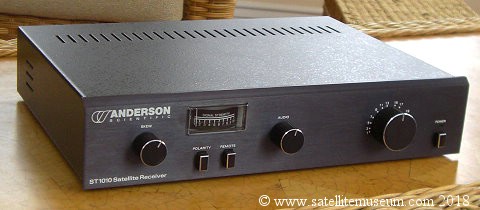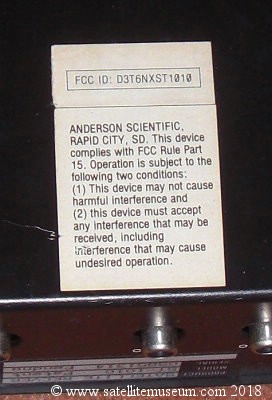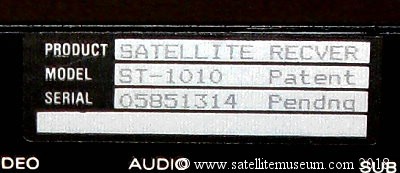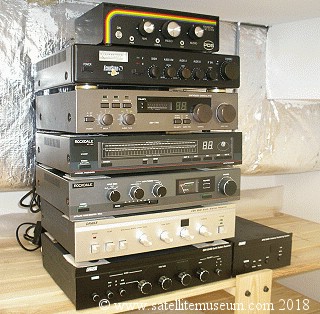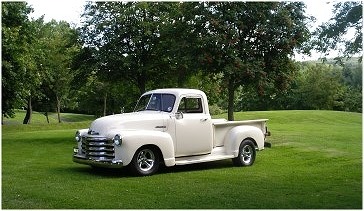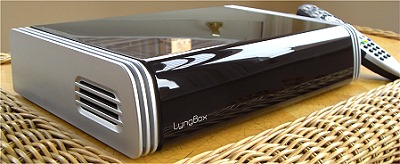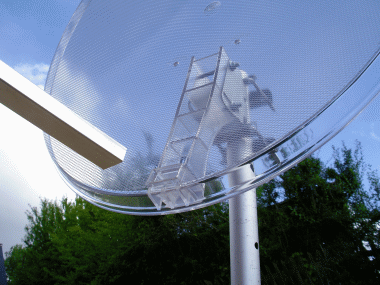Introduction.
I originally wrote this article in 2013 but based on new information I have decided to update this article in December 2017.
This new information involves a magazine donation (Wireless World) donated by Simon Tomsett in 2017 and from December 1985.
I have always maintained that there was no commercially available domestic satellite equipment before 1985 and that 1985
could be considered the year this started. This new article adds weight to this claim. It should also be noted that I have
"Satellite TV News" magazines from 1980 and 1984 and there is no mention of domestic satellite equipment in them. This is
an article about the early history of satellite TV and in particular when domestic satellite TV started in Europe and the UK.
Satellite TV News Spring 1982
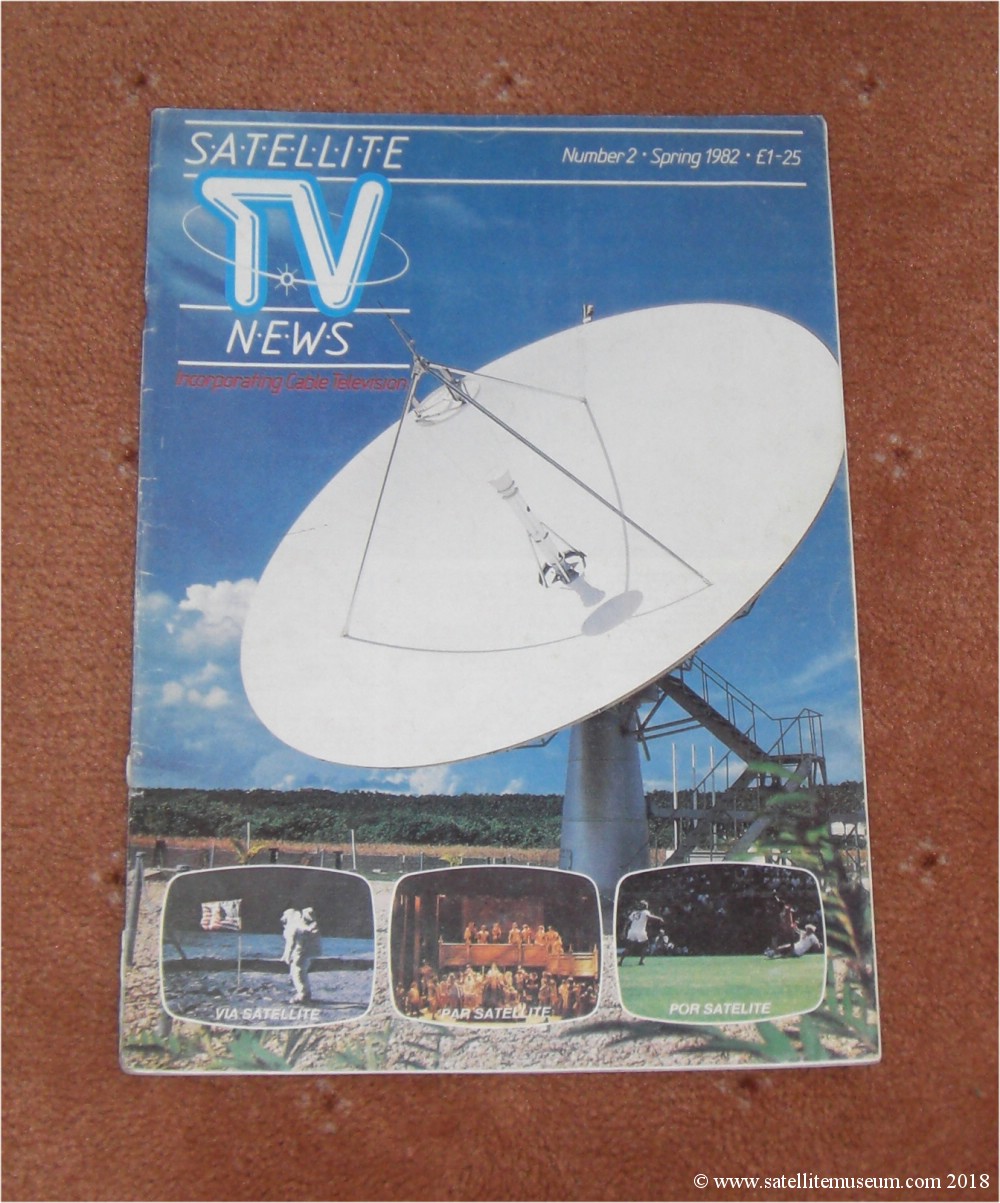
In this Satellite TV News magazine from Spring 1982, it's introduction states -
"Satellite transmissions in the States are in the 4 to 6GHz Band (mostly C Band - ED). Second generation satellites in the
12-14Gz Band (Eventually to be Ku Band - ED) will start in the mid 1980s. There is one test channel on the
"Orbital Test Satellite" (known as "OTS" - ED) at 10E and it can be received on a 10 foot (3m -ED) dish."
(The OTS satellite at 10E was aimed at Europe and needed at least a 3m dish for reception in the UK -ED)
The editor of Satellite TV News (which was the first ever dedicated satellite magazine) was Todd Slaughter.
I spoke to Todd via "Messenger" in May 2018 and he gave me the following information -
"I went to Atlanta to see a former Radio Luxembourg colleague DJ Kid Jensen who had recently become an anchor
on WTBS The Superstation, and we all went to a reception at the dish farm, The reason for the party - that
evening he was launching CNN. I was inspired having followed the development of satellite broadcasting since
the launch of Telstar in 1962. I contacted Colonel Parker in Las Vegas and he told me of a Satellite TV
exhibition at the Convention Centre, and he got me VIP tickets and Press Pass. Upon my return I had
meetings with both the BBC and ITV R&D management, and Satellite TV News was published.
Satellite TV news was published and edited by me for three years then it was bought by the Daily Express
group and re branded as Satellite & Cable TV news and ceased publication a year later just three months
prior to Rupert Murdock announcing the launch of Sky TV - it was always a quarterly. During the years that
I produced it there was only one direct broadcast test satellite OTS transmitting only 4 hours a day to no
more than 1000 receivers - this project was funded by Thames Television UK.
There were a few enthusiasts who had industrial parabolic receivers notably Steve Birkill who mounted a 12
foot Marconi dish onto a fire engine turntable controlled by hand by a series of pulleys - an amazing
character who showed me the delights of capturing international news and programme feeds from Arabsat,
Gorizont and the American networks."
Since the second issue was in Spring 1982, the first issue would have been Autumn 1981. It was published for
3 years and so the last issue would have been Autumn 1984.
Other information about the availability of channels in the UK before 1985 -
A Ku band test channel on OTS started in Oct. 1981 on 10E. Following completion of the tests the TV channel-
"Satellite Television" (also known as "Super Station Europe") started (on OTS at 10E) in April 1982 and transmitted
programs for 2 hours a day. This was the first TV channel to be transmitted to Europe (aimed at cable providers with
3m+ dishes). In August 1982 the channel increased it's broadcasting to 5 hours a day.
It is thought a small number (less than 50) of enthusiasts in the UK with large 3m+ dishes could receive this channel.
On 27th June 1983 the channel is bought by News International and in January 1984 it became the Sky Channel.
The ESCS-1 satellite (which was re-named Eutelsat1-F1) was launched on 16th June 1983 and became operational from 13E
on 12th Oct. 1983. The Satellite Television channel moved from OTS at 10E to this new more powerful satellite - ECS-1
at 13E. (ECS-1 was the abbreviation for the first European Communications Satellite, originally planned for
communications but demand meant it was also to be used for the transmission of satellite TV channels).
The switch of the Satellite Television channel from OTS at 10E to ECS-1 at 13E will have happened when ECS-1
became operational on 12th Oct. 1983 and reception was then possible on a 1.6m (min.) dish in the UK.
As stated the Satellite Television channel became the Sky Channel in January 1984.
There is no evidence of any domestic satellite equipment being available in the UK in 1984.
Only in 1985 is there evidence of domestic satellite equipment consisting of a lower cost domestic satellite receiver
with a dish of at least 1.6m diameter becoming available.
Wireless World December 1985
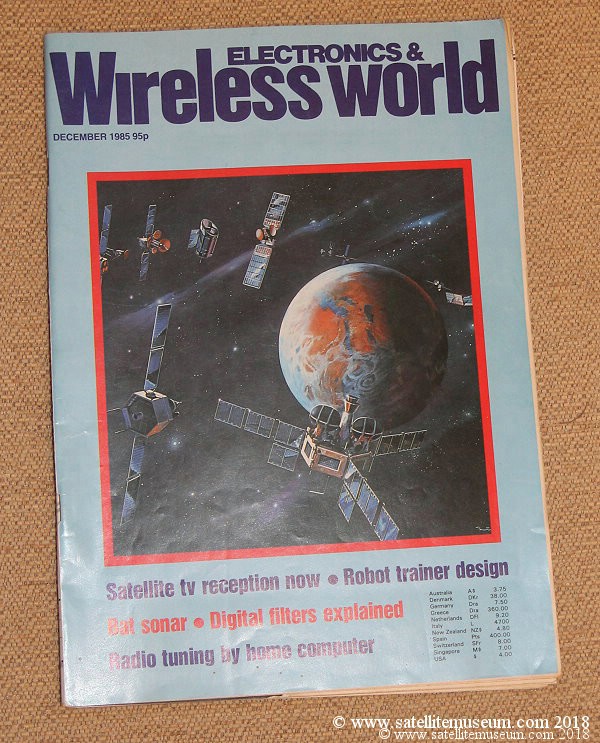
This magazine is from December 1985 and is an excellent source of information about satellite TV in 1985. A sister
magazine "Electronics World March 86", from the same publisher and from 3 months later follows below.
This "Wireless World" and it's featured article is about the state of the satellite industry in December 1985.
The title is "Satellite TV Reception Now"
It is interesting to start with the news section -
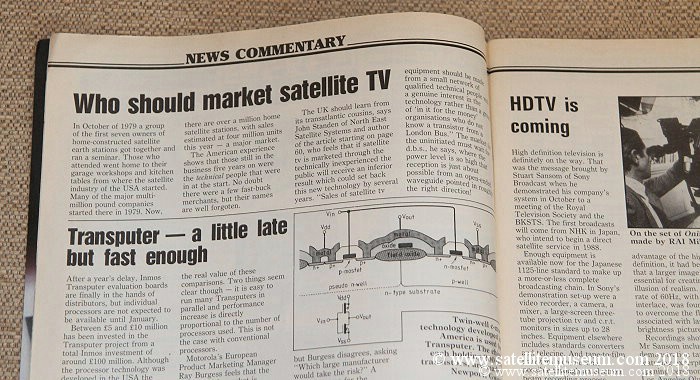
It starts "In October 1979 (That would have been about 6 years before this publication article - ED) a group of the first
owners of home-constructed satellite earth stations (These days we would call them "satellite systems" - ED) got together
and ran a seminar." This ties in with the first DIY domestic earth station (1976) built by Taylor Howard in the States and
indeed this seminar was also in the States. Although I have no evidence, it is likely Taylor Howard was one of the
7 people hosting the seminar. The news section also states that there are now (Dec. 85) 1 million home satellite systems in
the States. At this time the number of domestic systems in the UK was very small although you could find systems in colleges
and universities. The news also looks forward to dbs (high power, 12GHz smaller dishes) transmissions in the future.
Note there is also an article - "HDTV is coming." (Dec. 85) which was a long time before domestic HD televisions.
The article below from this Dec.85 edition was written by John Standen who was a technical director of
"Connexions Satellite Systems Ltd". There is an advert for Connexions Satellite alongside the article."
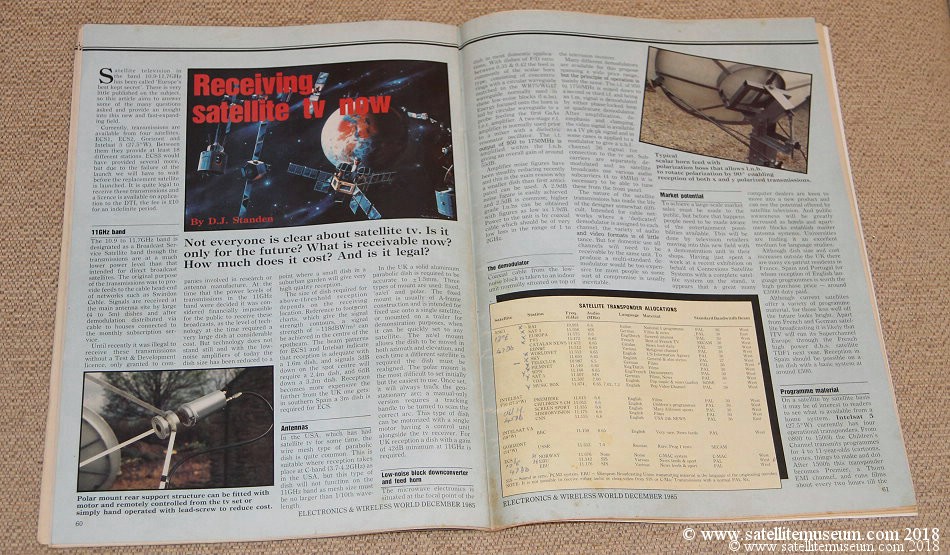
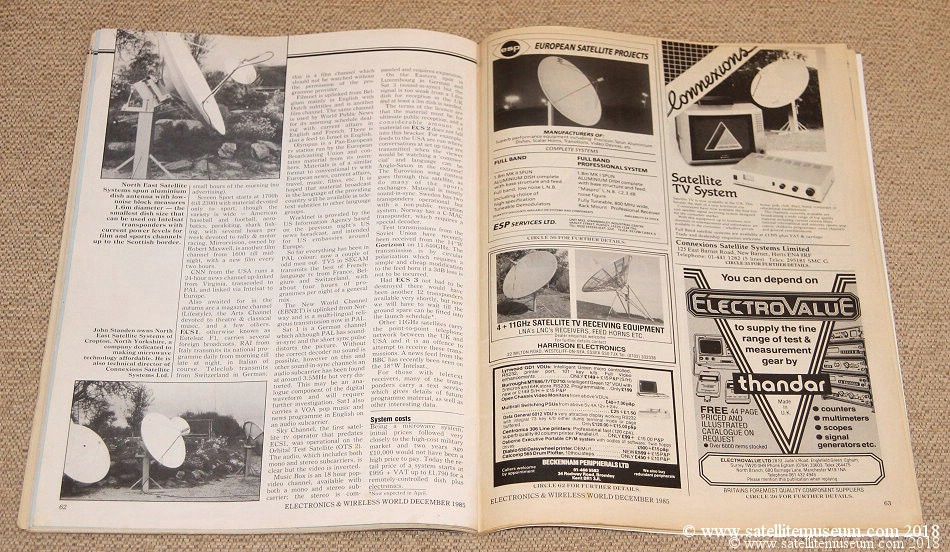
The salient points from the article are -
At the time of publication (Dec. 85) transmissions to the UK in the FSS band of 10.9-11.70 (more about bands below)
there are 4 satellites carrying at least 18 channels. These satellites are ECS-1, (Eutelsat1-F1 at 13E launched in 1983)
ECS-2, (Eutelsat1-F2 at 10E launched in 1984) Gorizont (A "Soviet" satellite at 14W) and Intelsat 5 (27.5W). The table
also includes a 5th satellite - Intelsat VA at 18W used by the BBC for rare "feeds" (A feed is not a channel, it is TV
programming being transmitted to another Earth station for use by the TV network at some future date.) There are other
feeds and test broadcasts in the table but the table includes 19 actual TV channels. 13 of these channels come from
ECS-1 at 13E and 5 from Intelsat F10 at 27W
They are - RAI from Italy, Sat 1 and Sat 3 from Germany, Europa (English and Dutch), TV5 from France, Filmnet from
Germany, EBNET (religious channel), a Norwegian channel, WPN (Eng/Dutch), CNN 24 hour news from the USA and in English,
Worldnet, Sky, VOA, Music Box, Premiere, Childrens Channel, Screen Sport and Mirrorvision.
To receive these channels (with "adequate reception") from Intelsat and ECS1 in the UK required a 1.6m dish.
The 18th channel was from Norway on ESC2 at 10E and was scrambled
In 1983 a (non domestic) satellite system would have cost about £10,000 but in Dec. 19 85 systems were available with
1.6m dishes from £995 + VAT to £1790 + VAT. The satellite system in the Connexions advert was £1395 + VAT.
There is a second advert from a satellite dealer called "Harrison Electronics" (which I remember well and
even traded with them in the early 1990s - ED) in Essex.
A Connexions satellite receiver from 1985 is in our museum and is detailed below.
Summary - What do we know about satellite TV when it started in the 1980s?
We know that domestic satellite TV systems were not in existence prior to 1985. A few enthusiasts had commercial or DIY systems
but receivers and dishes aimed at home users first appeared in 1985. At that time the minimum dish size for Ku band was 1.6m
Some TV channels for networks and re-transmission through cable we on C band and much larger dishes were needed.
Background Information -
At this point it is worth considering what C band and Ku band are so that comments from the magazine can be understood.
C band reception uses a frequency range of 3.7-4.2GHz. C band block type LNBs use a WR229G flange to bolt into a feedhorn
or polariser. C band was used for satellite reception from the start of satellite TV transmissions and is still used today.
Even today, large dishes (e.g. in the UK from 1.8m) are needed.
Ku band reception is from 10.7 GHz to 12.75GHz, (note. Ku band is from 10.5GHz to 18 GHz but the rest of the band is used
for transmission) however, Ku band reception is actually 3 bands. The FFS band from 10.7 GHz (originally it started at
10.9GHz but in the 1990s was extended downwards to 10.7GHz) to 11.7GHz. The DBS band from 11.7GHz to 12.5GHz and the
Telecom band from 12.5GHz to 12.75GHz (this may vary in America). Today these 3 bands (+the extension) are accessed using
a universal LNB. Most satellite TV reception all over the world uses "universal LNBs" for reception from these bands.
In 1986, (the date of the magazine) c band LNBs were in common use. These were, and still are single band LNBs. When the
magazine refers to Ku band it is actually referring to the FSS section of the Ku band and when it talks about the coming
of DTH (direct to home broadcasting using small dishes) it is referring to broadcasts from the DBS band. These days all
DTH satellite transmissions use all 4 sub bands of the Ku band reception frequencies.
In the mid 1980s to the early 1990s the references to Ku band was only the narrower FSS band (from 10.9-11.7) and a
single band block type LNB was used. A block type LNB had a WR75 flange and either bolted onto a single polarity
feedhorn or a polariser and feedhorn. A modern universal LNB is a quad band LNB as it covers FSS, DBS, Telecom and
the extension downwards from 10.9-10.7GHz.
In the early 1990s dual band, block type, LNBs were introduced. These were either FSS and Telecom, or FSS and DBS.
(Prior to that separate single band FFS and DBS LNBs could be combined using an OMT wave guide or FFS and Telecom LNBs
again were combined with an OMT). Later in the 1990s triple band block type LNBs were introduced and towards the end of
the 1990s quad band block type LNBs were manufactured including the lower extension. Quad band LNBs therefore cover the
whole of the KU band for TV reception. Originally quad LNBs were block type for a short while but then the universal LNB
became the industry standard quad band LNB. It differed from block type LNBs as it used 13/18V to switch polarity
(this is called "voltage switching") and a 22KHz tone to switch bands. Universal LNBs are either "LNBFs" (LNBs with integral
feedhorns) or LNBs with c120 flanges to bolt onto a separate feedhorn. These days the correct name "LNBF" has largely
disappeared and replaced with "40mm LNB" as the neck of the integral feedhorn fits on a 40mm support clamp. 40mm LNBs are
designed for offset dishes as they have an integral offset feedhorn. Modern c band LNBs are also LNBFs
as they have an integral feedhorn with options for prime focus or offset dishes. They have a 60mm neck for clamping
to the feed support arms. Modern combined c band and Ku band LNBFs are also available.
In 1988, in Europe, the Astra 1 satellite started transmitting TV channels in Ku band and dish sizes came down to 60cm.
The Ku band transmissions used a new voltage switching single (FSS) band LNBF. Although these smaller dished became
available in 1988 it was not until 1989 that dish sales became significant. This was mainly due to the new Sky TV channels.
The problem in the mid 1980s was to try to manufacture LNBs with electronics that would work at the very high Ku band
frequencies at 11and 12GHz. In 2012 some program providers are now using the Ka band at 19GHz.
Ka band LNBs are now widely available. The Irish channels from 10 east use Ka band.
Radio & Electronics World" from February 1986
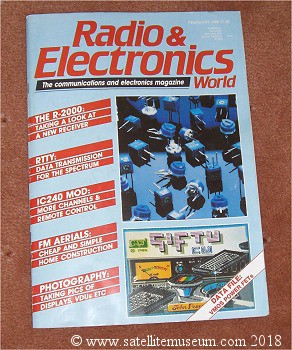
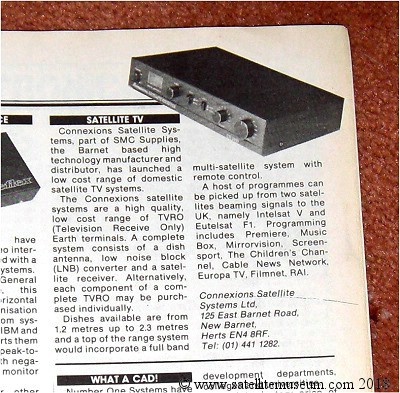
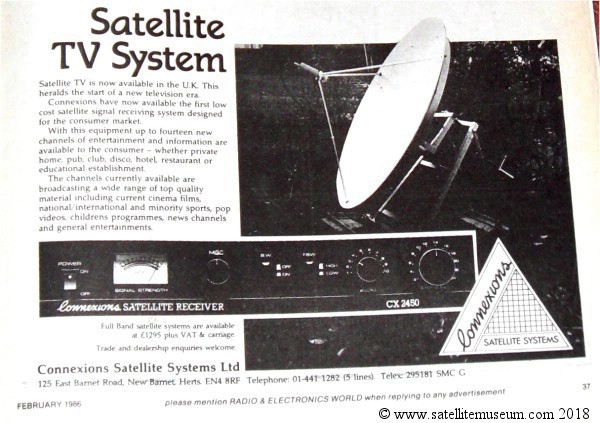
Once again the Connexions Satellite Systems Ltd are advertising their products. £1295 + VAT + Carriage.
Home Satellite TV magazine. July 1986.
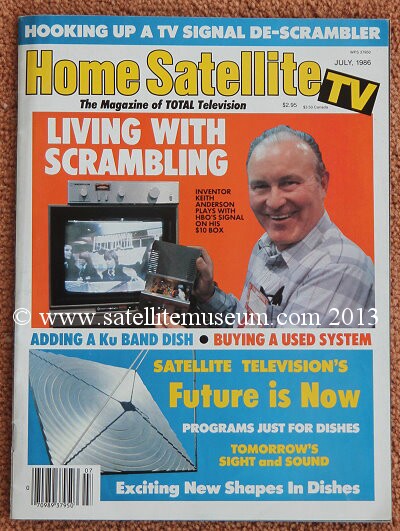
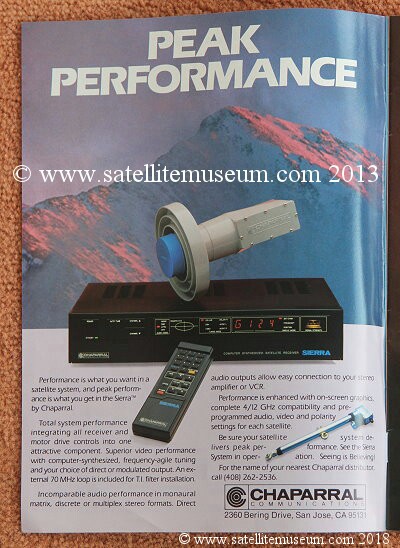
Our next magazine is, "Home Satellite TV" is from the USA and is dated July 1986. It provides us with an interesting insight into
the status and availability of satellite TV in the mid 1980s. The magazine talks about "the coming of Ku band" and smaller
dishes associated with Ku band transmissions. It also talks about the coming of DTH (Direct To Home) satellite TV and the
possible future use of dishes as small as 12 inches. (30cm).
Let us now go through some of the interesting articles in this magazine from 1986. On the cover is Keith Anderson from
Anderson Scientific. A well established company in 1986 with an excellent range of satellite receivers. He is featured
here talking about scrambling systems. In 2010 I spoke to Keith on the phone and he kindly sent me this magazine. He
retired some years ago but still takes a keen interest in satellite TV. Keith Anderson also wrote a featured article (below)
"You Can't Keep A Good Technology Down" (again his picture is in the article). More about Keith Anderson below.
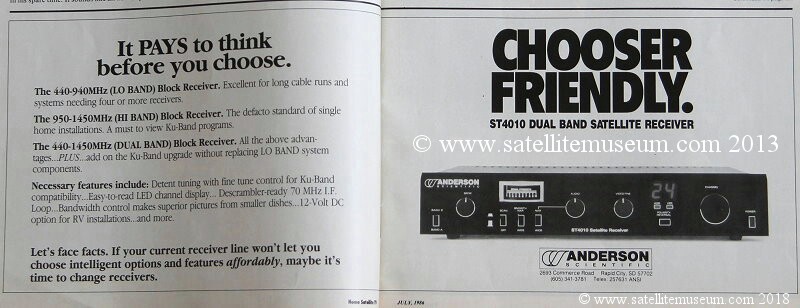
Adverts in a vintage magazine are always interesting. The inside cover shows the Chaparral Sierra receiver which never
came to the UK. The first Chaparral receiver in the UK was the Cheyanne followed by the fantastic Chaparral Monterey which,
most enthusiasts rated as the best and ultimate satellite receiver from 1990 - 2000. Chaparral also manufactured c band
feedhorns, Ku band feedhorns with polarisers, block type LNBs and the Chaparral Co-Rotor which was a combined feed / polariser.
Block type c band and block type Ku band LNB could be bolted to the two flanges on the Co-Rotor. The whole assembly
accessed both bands through a common feedhorn.
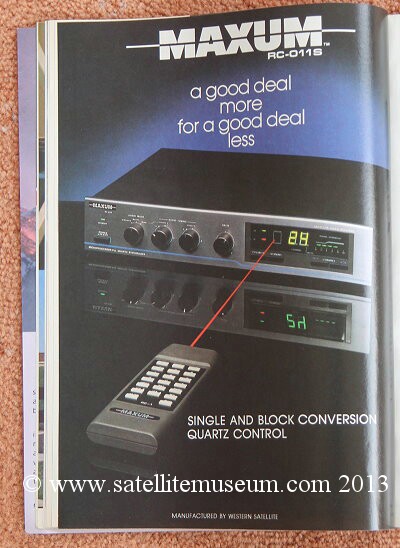
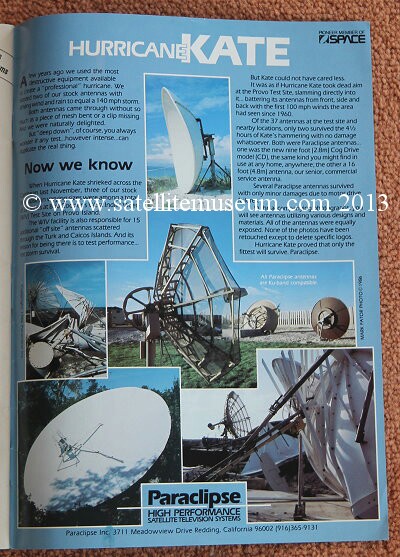
Other adverts include the Houston Tracker (another US product range) , Anderson Scientific ST4010, the Maxum RC011S
satellite receiver (we are still looking for a sample of this receiver to add to the Satellite Museum collection) and
Paraclips, a well-known dish manufacture. There are also adverts for books on satellite TV. These were pre-Internet days.
Books on satellite TV are less common these days since research can easily be done on the Internet.
The editors opening remarks are about finding a good installer and that is true today. I have found, however, with good
advice, an end user is capable of doing an excellent DIY installation themselves.
There is an interesting article - "Satellite Television's Future is Now" by Bob Wolenik" (the editor).
Here are some comments from the article -
"The future technical changes such as a possible switch to Ku band (a higher frequency requiring a slightly different
receiver and a smaller antenna) are already built into many units today. Many new receivers are both C-band
(the current standard) and Ku band compatible or upgradeable. And converting a dish to Ku band or buying a new Ku band
dish is relatively inexpensive". "The issue of zoning restrictions, which saw some cities obstructing the erection of dish
antennas has largely been laid to rest. The recent Federal Communications Commission ruling helps to prevent unreasonable
zoning to prevent dish construction. Chances are that no matter where you live, if you want to put up a dish, you
probably can." These comments refer to the inclusion of satellite dishes into the planning permission regulations in
the US. This is just as relevant today in the US, the UK and many other countries. " Today there are as many as 150
different video channels available to US viewers. Tomorrow there may be two way communications." Viewers in the UK
were used to 4 terrestrial tv channels (Channel 5 did not start until 1997). The idea of 150 satellite channels was
amazing. Today on a 1.0m motorised dish, over 8000 TV channels can be tuned in (this does not include radio stations).
"Of course that is not all. Hughes is working on mobile satellite communications. What's currently on the drawing boards
(meaning it is only 2 to 3 years off) is a system of both up-linking and down linking of an audio channel from moving
vehicles like vans or cars."
It probably took longer than 2 or 3 years but eventually TV channels were available on ships using tracking marine domes.
These domes are now available for motor homes, RVs, buses, trains and caravans.
These extracts are interesting since the talk about the future and we can now see how it all happened to an even greater
extent than was originally anticipated.
A second article titled "Strange happenings with a giant dish" gives us an insight into what was needed to receive
satellite tv in 1979 - 1980. It is written by Jim Vines.
"Nassau, Bahamas, September 1980 ......" "....... first some background information. Several months earlier this writer
demonstrated Intelsat reception with a small (for reception of Intelsat) 16- foot TVRO antenna. The occasion was the
industries second ever trade show. Bob Coopers SPTS '80/Miami (this writer also demonstrated his antenna at the
industries first ever trade show. SPTS '79 / Oklahoma City.)"
(TVRO- Television Receive Only).
He then goes on to talk about installing a 6m dish in September 1980. This dish weighed 1400 pounds (635Kg) and later
in the article he talks about it collapsing in windy weather due to using too small a polar mount! This was a 6m
motorised dish and the motor unit was not big enough!
In those days satellite TV was aimed at the large dishes of cable TV providers to receive and send down the cable
networks to US homes. Similar very large dishes were needed by the small number of enthusiasts who could then directly
receive the same channels in their homes or businesses.
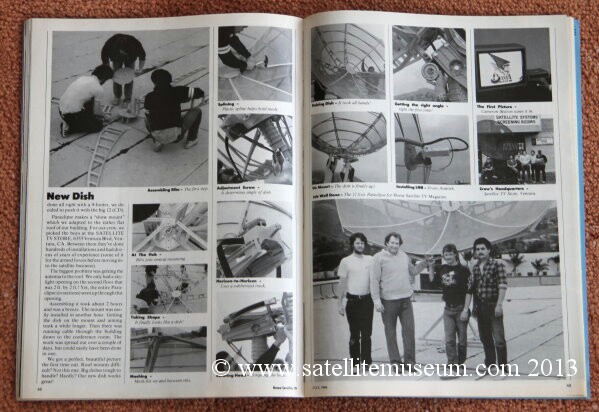
Another article titled "Our New Dish" about fitting a new dish in 1986 at "Home Satellite TV" magazines offices included
a detailed step by guide to fitting a motorised (Paraclipse) 12 foot dish. This was a mesh dish designed for C band reception.
Next there was an interesting article on "The Right Stuff For Your Dish". The article dealt with the different materials
that were used in the manufacture of satellite dishes. These comparisons are just as applicable today.
The article compares mesh, perforated and solid dishes. It also compares fibre glass with aluminium and steel.
Mesh dishes made with either steel or aluminium - these are used for c band reception. The holes (openings) are about 6mm
(1/4") across. At c band frequencies this works fine. At Ku band frequencies, the holes must be much smaller otherwise most
of the radiation (signal) will go through the holes. Solid dishes work fine with both c band and Ku band. C band dishes are
large and so mesh or perforated dishes are lighter and have less wind load. They may also look better since it is possible
to see through them.
Solid dishes are available in fibre glass as well as steel or aluminium. Steel is heavier and prone to rusting but cheaper.
Aluminium is lighter and does not rust (although it can corrode) and is more expensive. Aluminium is an excellent material
for dish reflectors as long as it is checked to be true and un-damaged during installation. The most expensive dishes are
fibre glass. They used to be mainly for professional installations but are available for the home user. They can also be
quite heavy depending how much reinforcement (webbing) is used in their construction at the back of the reflector. They are,
however, able to hold their parabolic shape indefinitely and are not prone to warping, they cannot be dented or deformed.
All of this is just as true today as it was in 1986. I have not quoted from the article as the comments in the magazine
are similar to those I have just outlined.
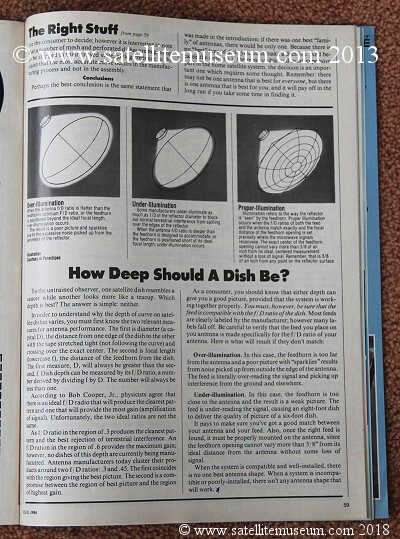
The article goes on to say "How Deep Should A Dish Be?".
Here the depth of dish is considered. In 1986 most dishes were prime focus. Here the positioning of the feedhorn
(at the correct focal length) and the f/D ratio of the feedborn is discussed. Both of these parameters are worthy of
discussion and are dealt with in our FAQ section at www.primesat.eu/satellite_faqs.php (Qu 2 and 3) however, the
f/D ratio is worth a mention here as it is the important ratio of the focal length of the dish to the diameter of the dish.
This will always be less than one. Also note that in 1986, the vast majority of dishes were prime focus.
(What is a Prime focus dish? See qu2 of the faqs). Here is another interesting extract-
"An f/D ratio in the region of 0.3 produces the cleanest pattern and the best rejection of terrestrial interference.
An f/D ratio in the region of 0.6 provides the maximum gain, however, no dishes of this depth are currently being manufactured.
Antenna manufacturers today cluster their products around the two f/D ratios: 0.3 and 0.45. The first gives the best picture.
The second is a compromise between the region of best picture and the region of highest gain."
Today, in the age of digital signals and effective bandwidth legislation there is no terrestrial interference and most prime
focus dishes are optimised with an f/D of around 0.6 for maximum gain. The feed horn also needs to have an f/D of 0.6 so that
it correctly illuminates the dish reflector. Not placing the feedhorn at the exact focal point, or using a feedhorn with an
f/D that is different to the f/D of the dish reflector causes either under illumination or over illumination of the dish reflector.
The former reduces the gain of the dish and the latter results in noise being picked up around the edges of the dish, reducing
the signal to noise ratio (which should be as high as possible). Whilst some dish manufactures make both the reflector and the
feedhorn and sell them together (this is called a matched feedhorn) more often than not the dish manufacture does not also make
a feedhorn and so it is then important to buy an adjustable f/D feedhorn from a different manufacturer. It is then possible to
adjust the f/D of the feedhorn to match the f/D of the dish. The f/D of the dish is found in the dish specifications.
The adjustment is made by rotating the scalar rings on a screw thread and checking the matching by optimising the signal,
quality and spectrum with a good satellite meter. An article titled "The Home Satellite Story" is worth quoting from -
"We can receive 24 channels per satellite (though all are not currently working or are not devoted to TV) and by moving
our dish horizon to horizon, pick up signals from other birds. Currently that means 117 channels."
This is an interesting snapshot of what was available in 1986. In the days of analogue transmissions only one channel was
possible per transponder and there were not many transponders on a satellite. Today in the digital age it is not unusual
to have 1000 - 2000 coming from a particular orbital position. There can be several satellites stacked in that position and
satellites can have many more than 24 transponders. Digital compression means that several channels can be on one transponder
all sharing the same frequency. The article also refers to an "LNA" (low noise amplifier) and a "down converter" fixed to the
mast. An LNB (low noise block) contains an LNA and a down converter. The down converter shifts the frequencies down from GHz
to MHz and it is the MHz frequencies that go down the cable and into the satellite receiver. The LNB also acts a bit like a
terrestrial mast head amplifier and amplifies the signal before it sends it down the cable. Coaxial cable is used as the
signal is both high frequency ac electricity and a wave. Coaxial cable both conducts electricity and acts as a wave guide.
Taylor Howard
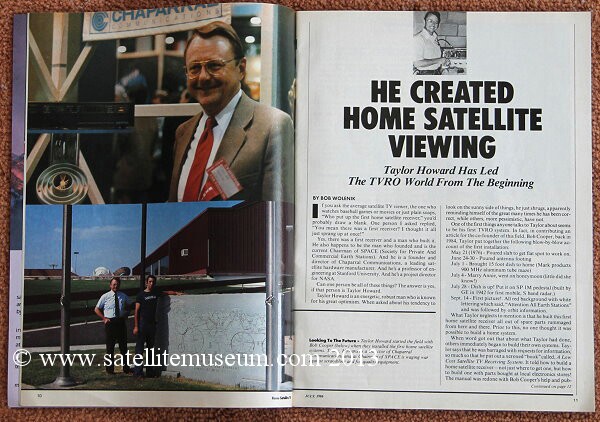
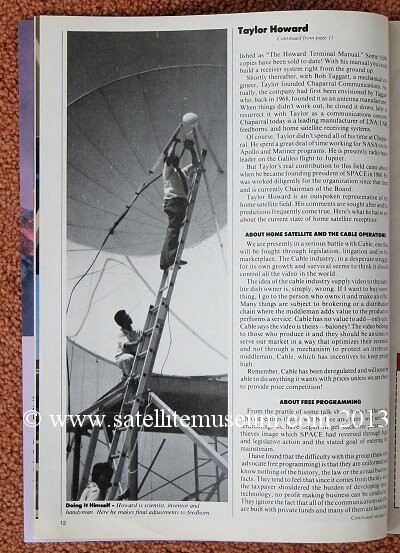
Another article is titled "He Created Home Satellite Viewing" and is about Taylor Howard. I will summarise rather than quote
from this article. Taylor Howard bought a 15 foot dish and started installation in his home in May 1976. (Although it is
not mentioned in this magazine, the dish was an ex military dish designed for radar which he modified). He built a satellite
receiver from parts from a local electronics store and received his first picture on the 14th Sept 1976. A red background with
white lettering saying "Attention All Earth Stations". He then wrote a manual called "A Low Cost Satellite TV Receiving System"
which later became a book called "The Howard Terminal Manual" and by 1886 had sold 6000 copies. Taylor Howard was the founder
and director of Chaparral Communications and was also a project director at NASA. In 1986 he was the radio team leader on the
Galileo flight to Jupiter. (I first met the Chaparral representatives at a trade show in London in 1989 unfortunately I don't
remember if Taylor was there at the time!) Sadly Taylor died in a plane crash in 2002 aged 70. He was piloting his own plane
when it crashed.
These days scrambling systems are the norm and viewers know there is a selection of channels on a satellite
that are free and a selection that are scrambled. A subscription is needed to view the scrambled channels (and sometimes a
dedicated receiver with embedded CAM, i.e. conditional access module is also needed). E.G. In the UK the free to air package
of many good and varied channels is called "freesat" and those needing a dedicated receiver, card and subscription mostly
come from Sky Television.
In 1986 this whole subject was very uncertain and worrying but first remember that satellite TV was aimed at large dishes
owned by cable providers for retransmission down cables and not directly to home users. At this time there was no provision
yet for direct to home broadcasting. The worries of home users are detailed in the following extracts -
From Taylor Howard "There is another common misconception, one that advertising will support home satellite TV
(this is the "let someone else pay" theory.) The trouble with cable and satellite direct to the home is that there are too
many channels for this type of support. There is not enough advertising money in the world to support 150 TV channels."
There is some truth in this statement today when taking considering the 1000s of channels available but it does not take into
account the low costs involved in running a modern digital channel or the options for low cost programming. Premium programming
usually does need a subscription unless it is government / licence fee supported like he BBC in the UK. There are exceptions,
however, where quality programming is supported by advertising.
Keith Anderson
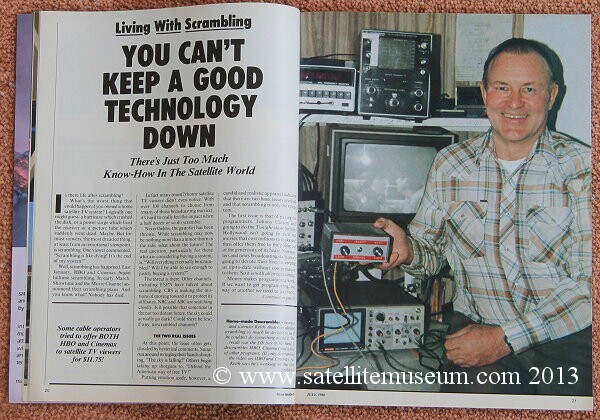
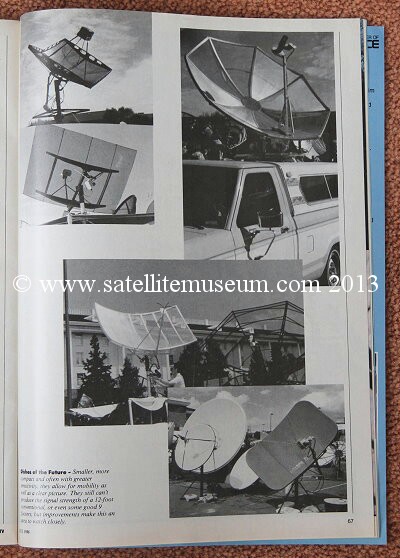
Keith Anderson said "what is the worst thing that could happen if you owned a satellite system? ...... From an emotional viewpoint,
is scrambling. One viewer pointed out scrambling is like dying. It is the end of my system."
These comments must, however, be put into context. The program's were, at that time, only aimed at the cable providers and not
the direct to home viewers. Home viewers had no access to the cable operators scrambling systems and so they saw the channels
that initially were free, starting to be scrambled and there was nothing that could be done to still view them. Initially
these channels came from HBO and were the clear but in 1986 they started to scramble them. Enter Keith Anderson with his 10
dollar box of tricks to make the channels clear again. Finally there is an article on "Exiting New Shapes" and is about
satellite antennas that are not circular or are not dish shaped. Included are rectangular shaped dishes and flat plate antennas.
Today we have transparent satellite dishes (we also have some that are not circular) and we have flat plate antennas so
little has changed apart from the latest dishes being much smaller than those in 1986.
See below a poster of the satellites that were available in 1986. This was in the magazine and was a veiw of the sky from Spain.
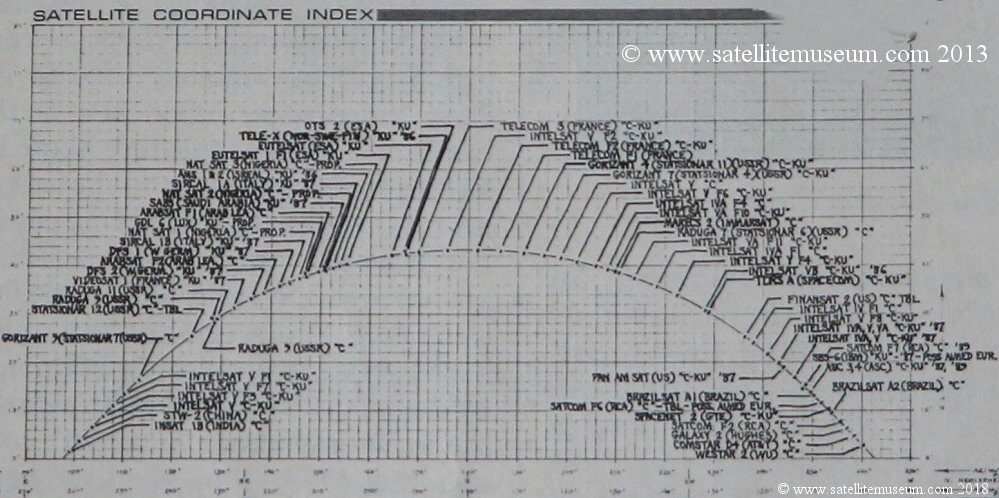
Who really built the first domestic satellite receiving system? Steven J Birkill?
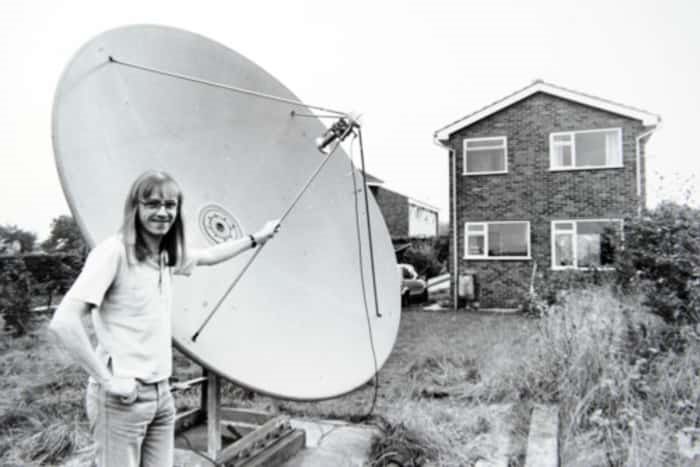
There is substantial evidence that Taylor Howard built the first domestic system in 1976 in the USA and all of that information
has been detailed above, however, is it possible the first system was actually in the UK a year earlier? There are some interesting
U Tube videos taken in 1982 and 1981 and other online reports about Steven J Birkill at his home in Sheffield. See above.
Also check-out the TV program "Blue Peter" in 1981 when he demonstrated his 8-foot dish satellite system. He built the
receiving equiment, the LNB and early satellite receiver (1978 - 81) but in 1981 a later professional receiver was used.
Reports online -
It was 1975 and, with just a modest homemade receiver and a homemade dish - built with the help of his father, a joiner -
Stephen became the first man in the world to receive satellite-transmitted programmes at home. I knew there was a future
in satellite television, says Stephen. It was a gut feeling that gave me the inspiration. I had done the sums and I
knew that it was technically possible, I just had to prove that it was practically possible.
And -
He made the first breakthrough at 12.30pm on December 13, 1975. With a five-foot dish and a receiver built on a circuit
board, Stephen managed to tune into an Indian TV programme. I was knocked out, he said. I had proven it was possible
and finally got recognition for it. The programme he tuned into was part of a NASA experiment known as SITE, which was
intended to beam literacy programmes to villages in rural India. Meanwhile in England RWT's co-founder Stephen J Birkill
had taken time out in 1975 from his duties as a BBC transmitter engineer, to build an experimental system for receiving
in England the SITE (Satellite Instructional Television Experiment) TV transmissions beamed to Indian villages, from
the NASA ATS-6 geostationary satellite at 860 MHz
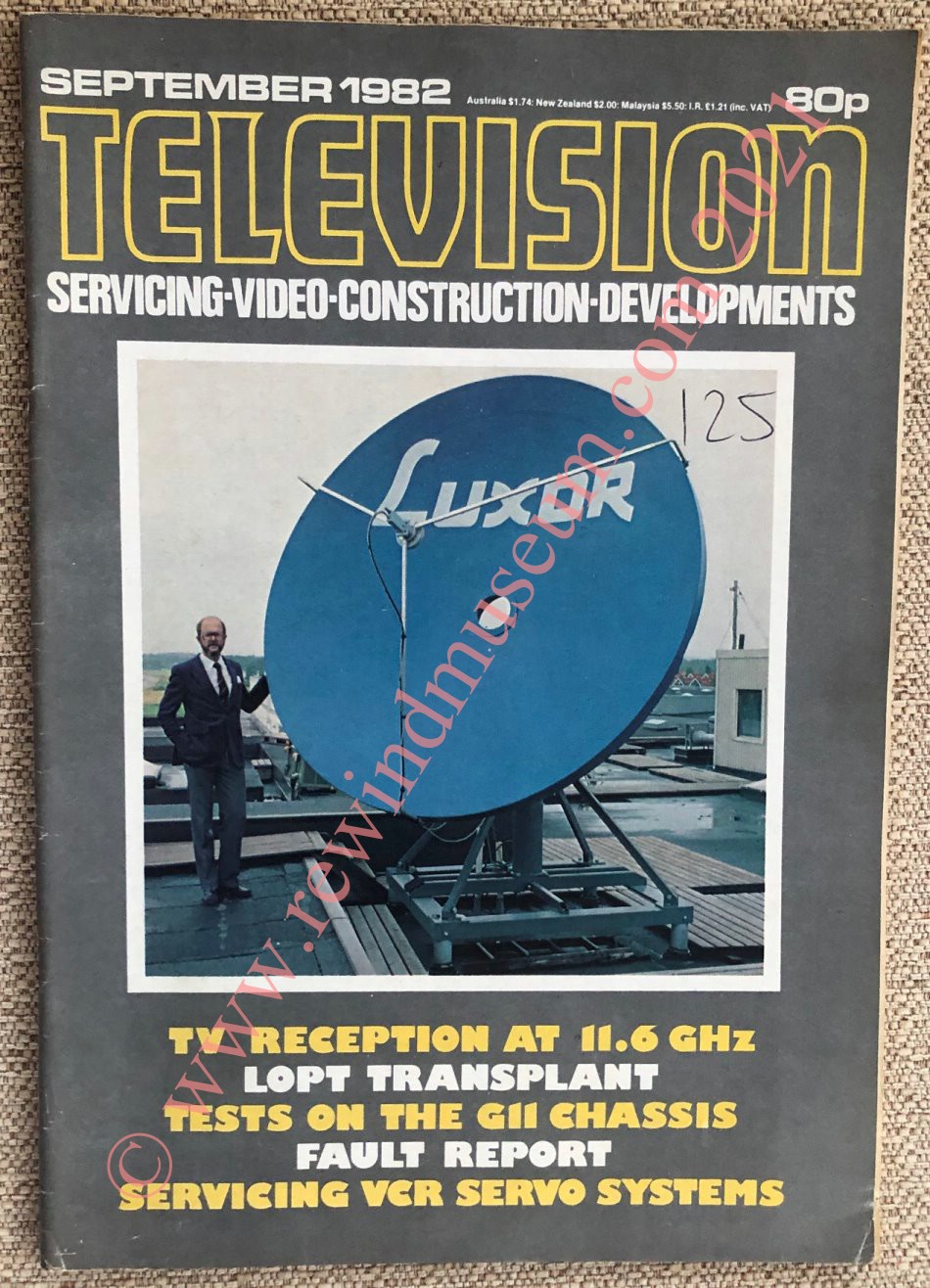
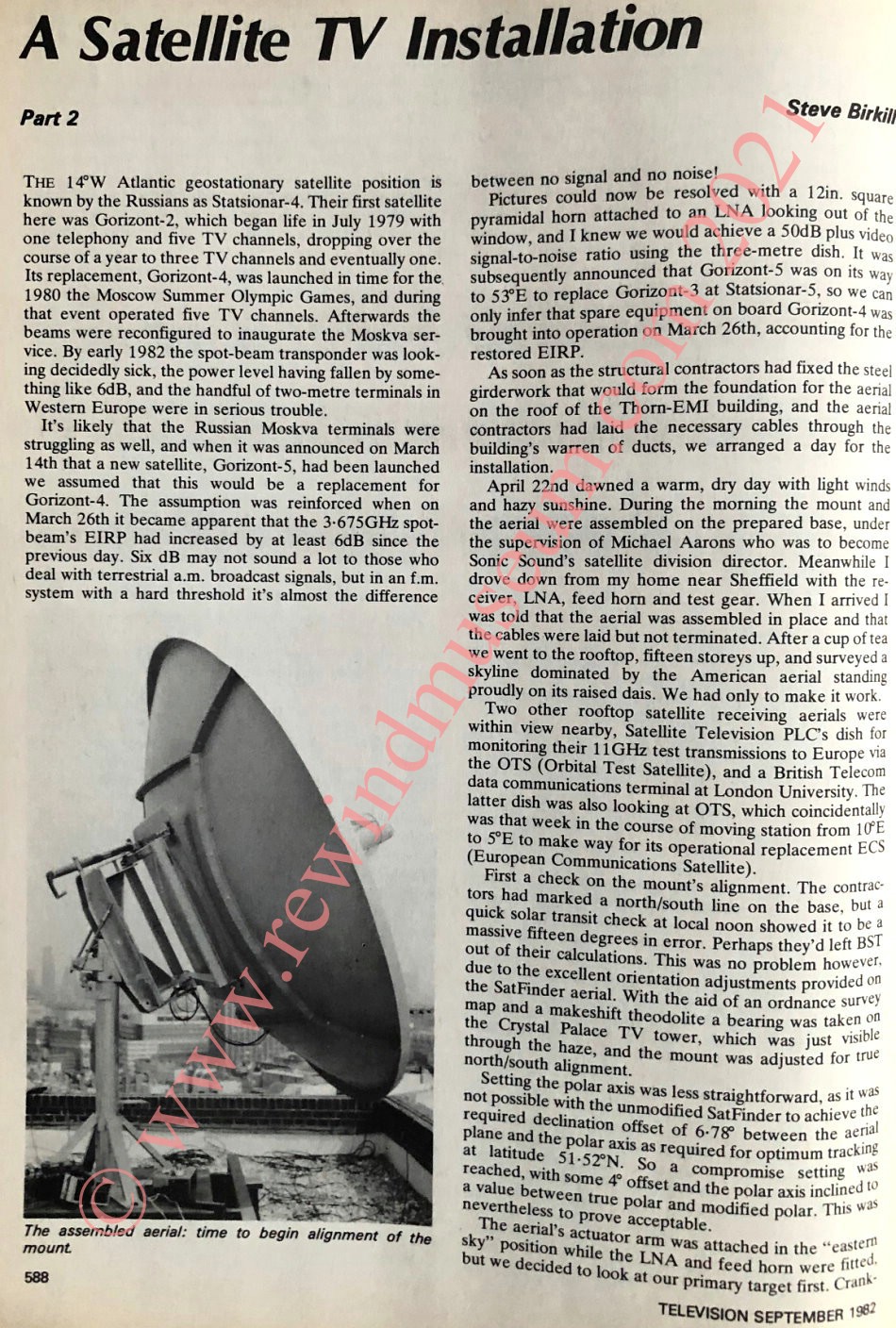
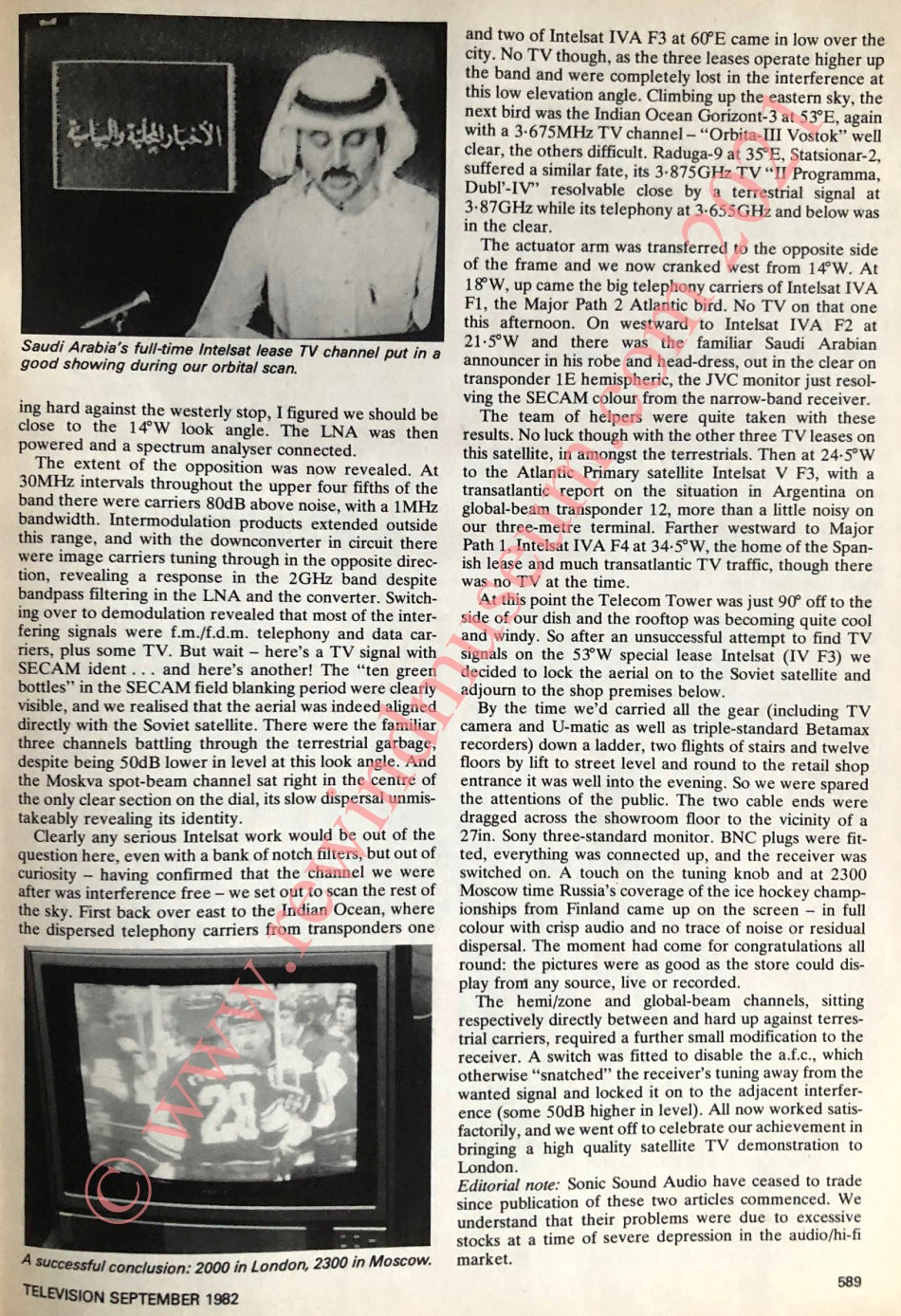
In Sept 1982 Steve wrote an article for "Television" magazine about satellite TV. Click here to read it.
In the mid 80s when he left "BBC Transmitters" for Bob Cooper's satellite setup in Oklahoma. This all fell apart a
couple of years later and Steve returned to the UK, It is rumoured that he was involved with designing the
Amstrad front end of their first satellite receiver range. Stephen moved to Canada in 2015.
Conclusions.
Let us consider what we have learnt from this 1986 magazine. Clearly some things have not changed. People still dislike scrambling
and will not subscribe to pay channels as a matter of principle rather than economics. Antenna options still include different
dish shapes but sizes are much less than they used to be. In 1986 c band was the norm and Ku band was something for the future.
Today, in the home, Ku band is the norm and c band is used by enthusiasts (although in countries like Africa and the middle east
it is still main stream).
The most important information in the magazine as far as the museum is concerned and from a historical standpoint, is the additional
time line information. This can be summarised-
Satellite TV time line -
1975 The first home satellite system in the UK is built by Steven J Birkill.
1976 The first home satellite system in the USA is built by Taylor Howard.
1975-1984. There is no evidence of home satellite systems (in particular receivers) being generally available. The small number of
home users either used commercial units or built their own based on the DIY books from people like Taylor Howard and Steven J Birkill.
1985. Domestic satellite receivers become available from companies like Chaparral, Drake, Anderson Scientific, and many more.
1988 (in Europe but possibly a little sooner in the States) Ku band transmissions start bringing dish sizes down
from 1.6m minimum in 1985 to 1.2m then to 60cm for some channels in 1988.
My time line -
From my own experiences I can add the following.
In 1982 I attended a course at Newcastle Polytechnic in the UK on satellite reception. (Geostationary for TV, communications and
weather and polar for mapping etc.) At the time satellite TV and weather satellites were grouped together in books and magazines
etc. I guess the enthusiast was interested in everything that could be received from satellites as there was not much TV at the time
but I had no interest in weather satellites at all and it was a mystery to me why this subject was linked to satellite TV.
In this course at the Polytechnic in 1982 a lecturer stated that he had built a complete system based round a 60cm dish. He
knew all of the technology worked but after extensive testing he could not receive anything as the dish was too small. He did
not know it at the time that it would be another 6 years before a 60cm dish would work on anything.
In 1989 my interests in satellite TV returned. I picked up a copy of "What Satellite" magazine in WH Smiths in Newcastle. I remember
my exact thoughts at the time (with some annoyance) were- "Why don't I know more about this subject". I was very knowledgeable on
other areas of consumer electronics but not satellite TV. I was very determined to rectify that problem. Indeed when I decide to
do something like this, at a technical level, it can become a bit of an obsession until I have thoroughly investigated the subject.
First I needed to buy a satellite receiver and install my own system. I looked at a Maspro 100s receiver and also the Chaparral
Monterey receiver. I bought the Maspro but within 24 hours realised my mistake and changed it for the (much more expensive)
Monterey. I learned a great deal during the installation and later that year I visited Chaparral Communications and a number of other
manufacturers and program providers at a trade show in London. At this time I was being asked by a number of people to supply and
install satellite systems so on a part time basis, I did so as an extension to our video production business. This was during 1989 and
1990 and included the "BSB squarial" receivers and flat plate antennas using the high quality MAC analogue system. In 1991 the
demands were so great I started our satellite TV business. The Internet was invented in 1993 and became free for all to use in 1994.
In March 1998 I built my first web site. In 2000 it became a full e-commerce site with a shopping cart at
www.satellitesuperstore.com and in 2012 www.primesat.eu was added. In Feb. 2007 www.rewindmuseum.com
was built and the satellite museum was part of this consumer electronics museum web site but in Nov. 2009
www.satellitemuseum.com was added.
In 1989 and into the early 1990s when customers purchased new equipment they would sometimes give me their old receivers and
these could date back to 1985. I kept all of them and they became the core of this museum. I hope you don't mind the advert
(our web addresses) but my own time line history, the relevance of how it crosses and relates to the history of satellite
TV and also putting into context how the museum started may help readers understand how this article came about.
I spoke to Keith Anderson (formally CEO of Anderson Scientific) on the phone in 2010 and I would like the thank him for
sending me the Home Satellite TV magazine from July 1986 so it could form the basis of this article. I hope it helps to
enlighten readers and future generations about he history and evolution of satellite TV especially in those early days.
From 2008 - 2010 I wrote a series of articles for "What Satellite" magazine.
I saved five of them and the links to those articles are -
"Motorised Memories" What Satellite magazine February 2008 issue.
"From Knobs to Switches" What Satellite magazine June 2008 issue.
"Bring Back the big Knobs" What Satellite magazine July 2009 issue.
"Air on a C Band" What Satellite magazine October 2009 issue.
"A History of Blind Search Receivers" What Satellite magazine February 2010 issue.
"Back To The Future with C Band" What Satellite magazine June 2010 issue.
Click here to see more old satellite magazines.
